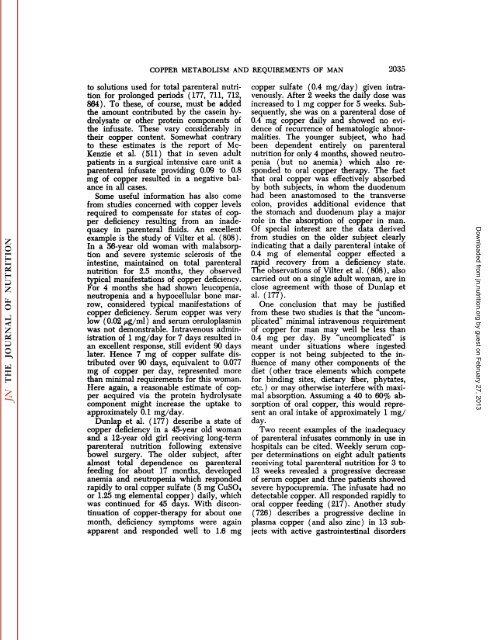conspectus of researchon copper metabolism and requirements
conspectus of researchon copper metabolism and requirements
conspectus of researchon copper metabolism and requirements
Create successful ePaper yourself
Turn your PDF publications into a flip-book with our unique Google optimized e-Paper software.
COPPER METABOLISM AND REQUIREMENTS OF MAN 2035<br />
to solutions used for total patenterai nutri<br />
tion for prolonged periods (177, 711, 712,<br />
864). To these, <strong>of</strong> course, must be added<br />
the amount contributed by the casein hydrolysate<br />
or other protein components <strong>of</strong><br />
the infúsate. These vary considerably in<br />
their <strong>copper</strong> content. Somewhat contrary<br />
to these estimates is the report <strong>of</strong> Mc-<br />
Kenzie et al. (511) that in seven adult<br />
patients in a surgical intensive care unit a<br />
parenteral infúsate providing 0.09 to 0.8<br />
mg <strong>of</strong> <strong>copper</strong> resulted in a negative bal<br />
ance in all cases.<br />
Some useful information has also come<br />
from studies concerned with <strong>copper</strong> levels<br />
required to compensate for states <strong>of</strong> cop<br />
per deficiency resulting from an inade<br />
quacy in parenteral fluids. An excellent<br />
example is the study <strong>of</strong> Vilter et al. (808).<br />
In a 56-year old woman with malabsorption<br />
<strong>and</strong> severe systemic sclerosis <strong>of</strong> the<br />
intestine, maintained on total parenteral<br />
nutrition for 2.5 months, they observed<br />
typical manifestations <strong>of</strong> <strong>copper</strong> deficiency.<br />
For 4 months she had shown leucopenia,<br />
neutropenia <strong>and</strong> a hypocellular bone mar<br />
row, considered typical manifestations <strong>of</strong><br />
<strong>copper</strong> deficiency. Serum <strong>copper</strong> was very<br />
low (0.02 fig/ml ) <strong>and</strong> serum ceruloplasmin<br />
was not demonstrable. Intravenous admin<br />
istration <strong>of</strong> 1 mg/day for 7 days resulted in<br />
an excellent response, still evident 90 days<br />
later. Hence 7 mg <strong>of</strong> <strong>copper</strong> sulfate dis<br />
tributed over 90 days, equivalent to 0.077<br />
mg <strong>of</strong> <strong>copper</strong> per day, represented more<br />
than minimal <strong>requirements</strong> for this woman.<br />
Here again, a reasonable estimate <strong>of</strong> cop<br />
per acquired via the protein hydrolysate<br />
component might increase the uptake to<br />
approximately 0.1 mg/day.<br />
Dunlap et al. ( 177) describe a state <strong>of</strong><br />
<strong>copper</strong> deficiency in a 45-year old woman<br />
<strong>and</strong> a 12-year old girl receiving long-term<br />
parenteral nutrition following extensive<br />
bowel surgery. The older subject, after<br />
almost total dependence on parenteral<br />
feeding for about 17 months, developed<br />
anemia <strong>and</strong> neutropenia which responded<br />
rapidly to oral <strong>copper</strong> sulfate (5 mg CuSO4<br />
or 1.25 mg elemental <strong>copper</strong>) daily, which<br />
was continued for 45 days. With discon<br />
tinuation <strong>of</strong> <strong>copper</strong>-therapy for about one<br />
month, deficiency symptoms were again<br />
apparent <strong>and</strong> responded well to 1.6 mg<br />
<strong>copper</strong> sulfate (0.4 mg/day) given intra<br />
venously. After 2 weeks the daily dose was<br />
increased to 1 mg <strong>copper</strong> for 5 weeks. Sub<br />
sequently, she was on a parenteral dose <strong>of</strong><br />
0.4 mg <strong>copper</strong> daily <strong>and</strong> showed no evi<br />
dence <strong>of</strong> recurrence <strong>of</strong> hématologieabnor<br />
malities. The younger subject, who had<br />
been dependent entirely on parenteral<br />
nutrition for only 4 months, showed neutro<br />
penia (but no anemia) which also re<br />
sponded to oral <strong>copper</strong> therapy. The fact<br />
that oral <strong>copper</strong> was effectively absorbed<br />
by both subjects, in whom the duodenum<br />
had been anastomosed to the transverse<br />
colon, provides additional evidence that<br />
the stomach <strong>and</strong> duodenum play a major<br />
role in the absorption <strong>of</strong> <strong>copper</strong> in man.<br />
Of special interest are the data derived<br />
from studies on the older subject clearly<br />
indicating that a daily parenteral intake <strong>of</strong><br />
0.4 mg <strong>of</strong> elemental <strong>copper</strong> effected a<br />
rapid recovery from a deficiency state.<br />
The observations <strong>of</strong> Vilter et al. ( 808 ), also<br />
carried out on a single adult woman, are in<br />
close agreement with those <strong>of</strong> Dunlap et<br />
al. (177).<br />
One conclusion that may be justified<br />
from these two studies is that the "uncom<br />
plicated" minimal intravenous requirement<br />
<strong>of</strong> <strong>copper</strong> for man may well be less than<br />
0.4 mg per day. By "uncomplicated" is<br />
meant under situations where ingested<br />
<strong>copper</strong> is not being subjected to the in<br />
fluence <strong>of</strong> many other components <strong>of</strong> the<br />
diet (other trace elements which compete<br />
for binding sites, dietary fiber, phytates,<br />
etc.) or may otherwise interfere with maxi<br />
mal absorption. Assuming a 40 to 60% ab<br />
sorption <strong>of</strong> oral <strong>copper</strong>, this would repre<br />
sent an oral intake <strong>of</strong> approximately 1 mg/<br />
day.<br />
Two recent examples <strong>of</strong> the inadequacy<br />
<strong>of</strong> parenteral infusâtescommonly in use in<br />
hospitals can be cited. Weekly serum cop<br />
per determinations on eight adult patients<br />
receiving total parenteral nutrition for 3 to<br />
13 weeks revealed a progressive decrease<br />
<strong>of</strong> serum <strong>copper</strong> <strong>and</strong> three patients showed<br />
severe hypocupremia. The infúsate had no<br />
detectable <strong>copper</strong>. All responded rapidly to<br />
oral <strong>copper</strong> feeding (217). Another study<br />
(726) describes a progressive decline in<br />
plasma <strong>copper</strong> (<strong>and</strong> also zinc) in 13 sub<br />
jects with active gastrointestinal disorders<br />
Downloaded from<br />
jn.nutrition.org<br />
by guest on February 27, 2013
















